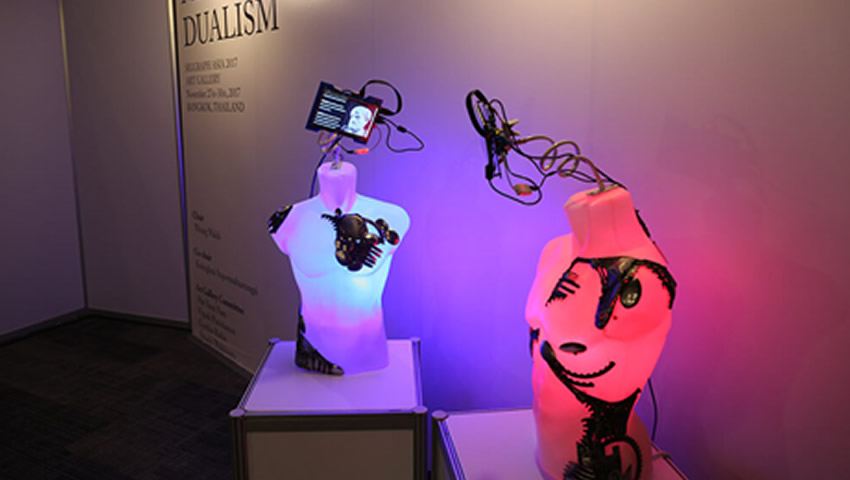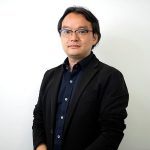Image of SIGGRAPH Asia 2017’s Art Gallery courtesy of ACM SIGGRAPH Asia
This post is part of a larger conversation that appeared on CG World Japan. This winter, SIGGRAPH Asia 2018 is to be held at the Tokyo International Forum (Yurakucho) from 4th to 7th December. In this fourth round of interviews, CG World spoke with Mr. Atsushi Wakimoto, Director of the CG-ARTS Cultural Division and committee member of SIGGRAPH Asia’s Art Gallery.
TEXT by Miyuki Ogata / Miyuki Ogata (CGWORLD) | PHOTO by Mitsuru Mitsuru Hirota
CGWORLD (C):Of all the programs in SIGGRAPH Asia, I think Art Gallery is one of the most unique programs. So to begin, can you tell us what is the Art Gallery?
Atsushi Wakimoto (Wakimoto):To be honest, some people will get confused by the definition of Art Gallery, it is hard to just jump in. One of the biggest reasons is because of the Art Gallery’s concept: ”unexpected encounters with expressions”. On one hand, programs such as Technical Papers, Technical Briefs and Posters are the places where you display the results of research involving CG. The Art Gallery is the place where you use those research technologies and apply it into art projects. We screen artworks for the Art Gallery based on the criteria that the piece is both the result of technology research, and is a complete piece of artwork.
C:So, it’s not enough to just say ‘we made this using technology’. And artwork that has nothing to do with technology is off topic. So to sum up, in order to qualify, the work needs to have both technology and creativity. You could say the Computer Animation Festival also meets these criteria, but the main difference is that the Computer Animation Festival only features videos, is that right?
Wakimoto: Exactly. Even though they are using the existing technology, their focus is more towards Media Art. In the Art Gallery, there is artwork that you can interact and play around with, and installations within the space.
C:How have your responsibilities for SIGGRAPH Asia shifted?
Wakimoto: 2017 is the first SIGGRAPH (in North America) that I participated in. I attended SIGGRAPH Asia back in 2009, and the memory that I had was that they had both students and professionals’ work featured at the same time, which I thought was very fascinating. I had never expected that I would became the Program Chair of Art Gallery for SIGGRAPH Asia 2015 in Kobe.
C: I had heard that people recommended you to be the chair, since you were managing art media festivals and the Campus Genius Contest for a long time, is that right?
Wakimoto: That’s not necessarily true. But the Japan Media Arts Festival and the Campus Genius Contest have the same process such as collecting the artworks, accepting submissions, examining the works, and then making the exhibition happen. These experiences made me confident that I could handle the responsibility, so last year and this year I decided to join the committee.
C: This year’s Art Gallery Chair and Co-chair are in Hong Kong (both working in the City University of Hong Kong). I can imagine that your experience with work exhibition management in Japan will be a huge support to them.
Wakimoto: Yes. Shipping and receiving of works, and anything to do with insurance wouldn’t work without me doing it (laughs). Also, taking into account what a huge success the SIGGRAPH Asia 2017 Art Gallery in Bangkok was, I am also consulting with Tobias Klein and Kyle Chung on how to make the Art Gallery in Tokyo even better, and how we can make it unique to Tokyo.

Art Gallery at SIGGRAPH 2017 in Bangkok. Image courtesy of ACM SIGGRAPH Asia
C: Could you tell us, what are the themes that you are trying for this year’s Art Gallery?
Wakimoto: One thing I found very unique is that the chair set a theme for both SIGGRAPH and SIGGRAPH Asia. In this year’s Art Gallery, there will be the exhibition called Candle TV created by Nam June Paik in 1975, and noh masks sculpted in traditional manner from Kyoto. Klein and Chung had set the theme that requires artists to figure out what they should display in interaction with these masterpieces.
C:It is like solving a mystery.
Wakimoto: Nam June Paik is considered to be the founder of video art. What would you display in the same space with his works if you are to display your own piece? That is the question raised here.
C:Will you be joining as an examiner for Art Gallery?
Wakimoto:Yes, together with Klein and Chung, I am also involved in examining the submissions. The number of submissions last year was about 130, out of which we chose 20. Half of the submissions were actually from America. But since this is SIGGRAPH Asia, we are hoping to see more submissions from all over Asia, especially Japan.
C: What are the job affiliations and occupations of the people who submit their work?
Wakimoto: SIGGRAPH Asia is also an academic conference, which is why we have lots of engineer researchers that submit work for the Art Gallery. And of course we have artists that submit their work, but also from people that are doing research for their own interest. But overall researchers are more dominant for SIGGRAPH Asia. I think everyone has been doing more research on their field, and although they have some options to show their results and announce them in public or let companies manufacture it, the other option is to have it as an artwork in Media Arts.
C: In other words, if you want to announce the results of your research you would submit to Technical Papers, Technical Briefs, Posters, etc. If you want to specifically prove the results of your research and try to make a product out of it, you would submit to Emerging Technologies. And if you want to have a message in it, and make you research as an artwork you would submit it to the Art Gallery?
Wakimoto: Exactly. However we do not have a special rule of categorizing works specifically. Although it is very important to know how you want to represent your work, but if you are not sure which program you should submit your work to, do not hesitate to consult with us. We can give you feedback on where would be the best place to showcase your work and get the feedback you’re looking for. In whatever form, I think it’s worthwhile to announce your achievements to the word – don’t be satisfied with only making things. Share them with people; those encounters will bring you the next opportunity. So by all means, please take advantage of the Art Gallery at SIGGRAPH Asia to share your works with the world.
 Atsushi Wakimoto graduated from Keio University in 1996 with a Bachelor of Arts in Environment and Information Studies. In 1999, he graduated from the college of literature in the department of Literature Philosophy, with a major in Art History. In 2002, he received his Masters Degree in Aesthetic Art History. In 2003, he became a part time lecturer in Intermedia Arts at Tokyo University of the Arts. He is currently working as the Director of Cultural Division in the CG-ARTS, and also helps with planning and producing events, including the Campus Genius Contest (sponsored by CG-ARTS). He was the chair for SIGGRAPH Asia 2015’s Art Gallery back in Kobe, and has continued to support the management of the Art Gallery program as a committee member at SIGGRAPH Asia 2017 and 2018.
Atsushi Wakimoto graduated from Keio University in 1996 with a Bachelor of Arts in Environment and Information Studies. In 1999, he graduated from the college of literature in the department of Literature Philosophy, with a major in Art History. In 2002, he received his Masters Degree in Aesthetic Art History. In 2003, he became a part time lecturer in Intermedia Arts at Tokyo University of the Arts. He is currently working as the Director of Cultural Division in the CG-ARTS, and also helps with planning and producing events, including the Campus Genius Contest (sponsored by CG-ARTS). He was the chair for SIGGRAPH Asia 2015’s Art Gallery back in Kobe, and has continued to support the management of the Art Gallery program as a committee member at SIGGRAPH Asia 2017 and 2018.



